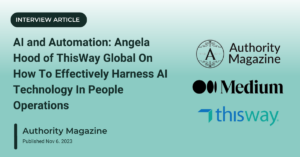With the fast pace of technological innovation today, businesses have increasingly embraced digital transformation.
COVID-19 turned the dial up. In fact, a massive 97 percent of business leaders reported speeding up the pace of digital transformation (some by as much as 6 years) because of the pandemic.
In 2022, 61 percent of companies are continuing down this trend. Specifically in HR, businesses expect a 9 percent increase in spending on HR technology.
Because of the importance of HR in the organization and culture, digital transformation in HR has far-reaching effects on employees and businesses. Here, we’ll explore what those are, along with the role HR plays in the digital transformation of organizations.
First, let’s dive into what it is, specifically related to HR and recruiting.
What is Digital Transformation?
Digital transformation is when businesses incorporate technology in their processes to remain competitive. Microsoft outlines digital transformation in 4 main areas, including business operations, employee experience, customer experience, and product and service offerings.
Digital transformation can apply to all aspects of HR operations and the employee lifecycle, including hiring, engagement, performance management, training, benefits, and compensation.
Some HR digital transformation examples include implementing cloud-based HR systems, applications that help facilitate remote work, training and learning management systems, incorporating the use of artificial intelligence in human resources, and applicant tracking systems and sourcing technology.
Benefits of HR Digital Transformation
Updating HR operations with technology delivers a range of benefits that impact organizations and show why digital transformation is important in the HR process.
Here are some of the major benefits of digital transformation in HR and recruitment.
Time Saved on Manual Processes
Automating manual processes can help increase productivity and efficiency. With the time savings, HR leaders are free to spend more time focusing on strategic initiatives.
Improved Data Storage and Availability
Cloud-based systems centralize your data, making it easier to access and manage it and allowing for better recordkeeping and compliance.
In addition, having more accurate data and information for reporting and analytics enables HR to make more informed, data-driven decisions.
Finally, with the right measures in place, businesses can ensure employee data is more secure.
Enhanced Employee Engagement
Hiring and keeping good talent has become harder since COVID-19. Digital transformation can help HR better monitor and address employee needs.
This can include empowering employees to work more efficiently, improving collaboration, or creating opportunities for professional development.
Initiatives that improve the employee experience allow workers to feel more valued, challenged, and motivated while improving productivity and retention.
Effective Recruitment and Candidate Engagement
With the ways digital technology lets us communicate online, businesses can cast a wider search to find more qualified candidates for open roles.
With 58 percent of HR leaders citing diversity and inclusion as a major initiative for them in 2022, technology can provide employers with more avenues and opportunities to connect with more diverse candidates.
5 Ways to Integrate Digital Transformation in Recruitment and HR
- Identify areas for improvement. Look for points of friction in the employee experience or HR operations. This can include paperwork or manual data entry that can be simplified with technology.
- Define your goals. Understand what you’d like to accomplish with digital transformation. Having a clear vision and goal serves as the foundation for your strategy to ensure you’re moving in the right direction. Set concrete KPIs and metrics to track and measure progress and success. With these in place, you can create a plan and timeline.
- Get proper buy-in. To foster long-term change, leadership and other teams need to be on board as well. Everyone should understand the initiative’s goals, along with their roles and responsibilities. Working toward a common end helps promote better collaboration and engagement.
- Keep communication open. Transparency keeps people on the same page and gives everyone access to the same information to accomplish their goals more effectively. Have clearly defined processes and training laid out for employees to set expectations. Clear communication also improves employee morale and efficiency.
- Testing and iterating. Continuously monitor feedback and results after launch to assess your changes. From there, you can adjust to meet the unique needs of your organization and its employees.
People at the Core of HR Digital Transformation
Over the years, technology will continue to advance, giving businesses more tools to drive productivity and efficiency and better experiences for candidates, employees, and customers alike.
Companies that embraced digital transformation reported stronger financial success. In 2020, Deloitte found that businesses with higher digital maturity were nearly three times more likely than those with lower maturity to see net revenue growth and profit margins above the industry average.
To stay competitive while hiring and keeping top talent, businesses will have to continue evolving their processes, embracing more digital transformation in HR.
In tailoring your digital transformation strategy, people should be at the center. Technology shouldn’t replace the human aspect of HR, but help to enhance it by expanding the opportunities to create better candidate and employee experiences for your business.








